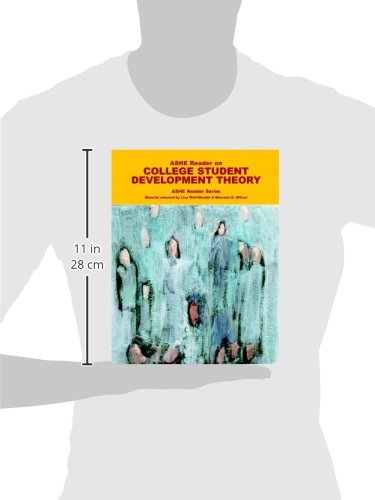


Full description not available
D**N
Resource
Excellent resource for scholars of student development!
A**I
It's a textbook! What can I say?
Not sure how you rate a textbook! It's not overly exciting, the print is small, editing is poor (typos and errors abound). The spine cracks and pages fall out after minimal use. It's expensive. And it's cumbersome (the size and heft of a big-city telephone book). But you're required to purchase it, so Amazon is a whole lot cheaper than buying it elsewhere!
S**N
A great ASHE reader on students - for anyone in student ...
A great ASHE reader on students - for anyone in student services in higher education, this volume breaks down students' needs in easy-to-read chapters.
G**E
Five Stars
Very helpful, used it for my disertation
L**U
ASHE reader
I purchased new and received perfectly on time, paid over $115 only to discover that the back cover was cut and the front cover had scuff marks. Had to tape it so that back cover wouldn't tear some more.
J**R
Solid text - great entry into the world of student development
This ASHE Reader is a nice compilation of various theories on college student development. Anyone looking for the fundamental theories should start here. This review will provide a quick overview of the different areas featured in the text followed by general impressions of the entire text. There are six overarching sections: (1) Introduction to the study of student development theory; (2) Holistic versions of student development; (3) Intrapersonal/interpersonal dimensions; (4) Cognitive dimensions of development; (5) Theory to practice; and, (6) Additional readings list.(1) Introduction to the study of student development theoryThis section provides a nice starting place and provides the tools and the knowledge for understanding theory and the importance of theory. There are three articles in this section. This unit of the reader may not be as important to some people depending on previous knowledge and usage of other theories, developmental or not.(2) Holistic versions of student developmentThis unit of the reader is divided into two parts: integrated developmental models and spiritual and faith development. Love and Guthrie have a nice article about Kegan's orders of consciousness; in fact, it is easier to read and comprehend than Kegan's actual article. I think it is important to read the original source, but for comprehension's sake, follow-up with Love and Guthrie's article. The articles about spiritual development are written by Sharon Parks, Patrick Love and Donna Talbot, and Dafina Stewart.(3) Intrapersonal/interpersonal dimensionsThis unit of the reader is further divided into five sections: psychosocial development, dynamics of race and ethnicity in development, dynamics of gender in development, dynamics of sexual orientation in development, and multiple dimensions of development. This unit makes up a majority of the reader and encompasses many theories on psychosocial development. Newcomers to student development will probably find Chickering's seven vectors the easiest to understand and the most applicable. From my experience, Chickering's theory spans such a broad range of college experience and is the simplest way to start incorporating theory into practice. Another important article is Helms' introduction to racial identity terminology. There are also articles that cover specific racial identities of which it is important for any student affairs administrator to have at least a vague understanding.(4) Cognitive dimensions of developmentThis unit contains two sections: intellectual development and moral development. Classic theorists (Perry, King, Kitchener, Kohlberg, and Gilligan) have provided articles for this section. This section provides theories and articles about intellectual development and moral development. Personally, I found the theories by Kohlberg and Gilligan to be of greatest interest (care and justice based moral reasoning). All of these articles are "must-reads" for all student affairs professionals.(5) Theory to practiceThis section is basically a conclusion to the entire reader and how student development affects higher education policies and how to implement developmental models into everyday practice.(6) Additional readings listThis section is pretty self-explanatory. There are plenty of readings for a specific area of interest.This is a solid introduction to student development theory. For newcomers to the student development world might be a little hesitant about the sheer size of this reader, but be assured that not every one of the 49 articles are a fresh and different theory. Many of the articles simply provide support or alternative views for previous theories in each section. Unfortunately, it may be difficult at first to determine which articles are actual theories. I highly recommend this text for anyone looking for an entry into the world of student development.It is nice to see that the price on Amazon finally lowered the price - when I purchased this book it was listed as 200-plus dollars. However, I bought it straight from the publishing company for much cheaper than Amazon was offering.
Trustpilot
1 week ago
2 months ago